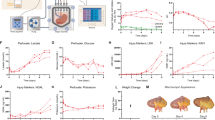Abstract
Preservation of the donor heart during transport is of paramount importance for a successful transplantation procedure [1,2]. An increase in the preservation window from the current 4 — 5 hours to over 24 hours [3,4] would lead to more compatible cross-matches and wider geographical harvest of transplantable hearts. In spite of the large amount of research on the development of solutions and modalities, there is still much to be learned to achieve optimal organ preservation. Preservation solutions have evolved from simple high-potassium buffers to complex recipes [3,4].
Access this chapter
Tax calculation will be finalised at checkout
Purchases are for personal use only
Preview
Unable to display preview. Download preview PDF.
Similar content being viewed by others
References
R. Hetzer, H. Warnecke, and S. Schuler, (1986) The Donor Heart: Procurement, Selection, and Preservation. TranspL Proc. 28,27–30.
J.M. Levett, and R.B. Karp, (1985) Heart Transplantation, Surgical Clinics of North America, 65,613–635.
J.M. Burt and J.G. Copeland, (1986) Myocardial function after preservation for 24 hours, J. Thorac. Cardiovasc. Surg., 92,238–246.
W.N. Wicomb, D. Novitzky, D.K.C. Cooper, and A.G. Rose, (1986) Forty-eight Hours Hypothermic Perfusion Storage of Pig and Baboon Hearts, J. Surg. Res., 40, 276–284.
C.J.A. Van Echteid, and T.J.C. Ruigrok, (1987) Nuclear Magnetic Resonance Spectroscopy in Experimental Cardiology in “Non-invasive Imaging of Cardiac Metabolism” Dordrecht Martinus Nijhoff Publ., 265–277.
G.A. Elgavish, (1987) NMR Spectroscopy of the Intact Heart in “Biological Magnetic Resonance”, L.J. Berliner and J. Reuben, eds., Plenum Press, New York, 81–127.
R. Deslauriers, W.J. Keon, S. Lareau, D. Moir, J.K. Saunders, I.C.P. Smith, K. Whitehead, and G.W. Mainwood, (1989) Preservation of High Energy Phosphates in Human Myocardium — A 31P NMR Study of the Effect of Temperature on Atrial Appendages. J. Thorac. Cardiovasc. Surg., (in press)
G.W. Mainwood, S. Lareau, K. Whitehead, W.J. Keon, and R. Deslauriers, (1989) The Effects of Temperature and Buffer Concentration on the Metabolism of Human Atrial Appendages Measured by 31P NMR, Adv. in Exptl. Med. & Biol. — Oxygen Transport to Tissues, 12, K. Rakusan, G. Biro & T. Goldstick, eds., Plenum Press, N.Y. (in press).
R.J. Connett, (1988) Analysis of Metabolic Control: New Insights Using Scaled Creatine Kinase Model, Am. J. Physiol, 254, R949–R959.
J.R. Neely, and L.W. Grotyohann, (1984) Role of Glycolytic Products in Damage to Ischemic Myocardium, Circ. Res., 55, 816–824.
T.A. English, J. Foreman, D.G. Gadian, D.E. Pegg, D. Wheeldon, and S.R. Williams, (1988) Three Solutions for Preservation of the Rabbit Heart at 0° C, A Comparison with Phosphorus-31 Nuclear Magnetic Resonance Spectroscopy, J. Thorac. Cardiovasc. Surg., 96,54–61.
L.D. Shorr, R.T. Thompson, G.D. Marsh, F.M. Keith, A.A. Driedger, and D.J. Magilligan, Improved Preservation of Isolated Rabbit Hearts Using Oxygenated Cardioplegic Solutions. A 31P NMRS Study, (private communication).
H. Takami, H. Matsuda, S. Oumi, H. Watari, E. Furuya, K. Tagawa, and Y. Kawashima, (1987) Assessment of Possible Compartmentalization of Myocardial ATP and Characteristics of Depletion Under Ischemia Utilizing 31P NMR, Circulation, 76,247.
H. Takami, E. Furuya, K. Tagawa, Y. Seo, M. Murakami, H. Watari, H. Matsuda, H. Hirose, and Y. Kawashima, (1988) NMR-Invible ATP in Rat Heart and Its Changes in Ischemia, J. Biochem., 104,35–39.
Author information
Authors and Affiliations
Editor information
Editors and Affiliations
Rights and permissions
Copyright information
© 1989 Plenum Press, New York
About this chapter
Cite this chapter
Forester, G.V. et al. (1989). 31P NMR Studies of the Metabolic Status of Pig Hearts Preserved for Transplantation. In: Rakusan, K., Biro, G.P., Goldstick, T.K., Turek, Z. (eds) Oxygen Transport to Tissue XI. Advances in Experimental Medicine and Biology, vol 248. Springer, Boston, MA. https://doi.org/10.1007/978-1-4684-5643-1_61
Download citation
DOI: https://doi.org/10.1007/978-1-4684-5643-1_61
Publisher Name: Springer, Boston, MA
Print ISBN: 978-1-4684-5645-5
Online ISBN: 978-1-4684-5643-1
eBook Packages: Springer Book Archive




